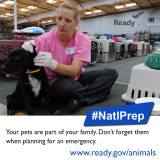How To Get Kitty Disaster Prepared
September is National Preparedness Month. When sudden disasters occur it is so easy to get stressed  and confused. This is why it is important to prepare now in “peace time”. You have made your kit, plan and are staying inform, good for you. But what about your kitty? Is your cat prepared for the next disaster? How to get kitty disaster prepared.
and confused. This is why it is important to prepare now in “peace time”. You have made your kit, plan and are staying inform, good for you. But what about your kitty? Is your cat prepared for the next disaster? How to get kitty disaster prepared.
August 29th 2005, one of the five most deadliest hurricanes in the history of North America struck. Hurricane Katrina made landfall as a Category 3 hurricane and pack winds of 125 mph. When it was through, over 1,800 people were dead. How many of these lives could have been saved if they were allowed to evacuate with their pets? Many people refused to leave New Orleans because they were not allowed to bring their pets. To many people, pets are like their children. According to a survey that took place after Hurricane Katrina, 44% of the people that decided to stay in the city and not evacuate did so because they were told that they could not take their animals with them. However, as the storm got closer and intensity increased the evacuation changed to mandatory. It is hard to know for sure how many pets were left as a result of the forced evacuation. According to The Louisiana Society for the Prevention of Cruelty to Animals, “Estimates that 70,000 pets remained in the city during the storm; of those about 15,000 were rescued.” Sadly, only 20% of the animals that were rescued got reconnected with their owners.
The good news is that as a direct result of the catastrophes that took place during the evacuation of New Orleans that involved animals President George Bush signed into act PETS (Pets Evacuation and Transportation Standards Act). It is now public law therefore, cities have to be sure to include all pets in their evacuation plans. If it is not safe for you to stay then it is not safe for your cat to stay.
How To Prepare a Cat Emergency Kit
Here is a list of items that you should have in your kitty emergency kit:
- Food: Make sure that you have at least enough food for one week. Most agencies suggest three days but, as we discovered with Hurricane Katrina, three days is not enough. Bring the food they are use to eating and keep it in a waterproof container. Don’t forget a bowl to feed them in and a manual can opener.
- Water: Be sure to have extra water on hand for your cat. Again, don’t forget a bowl.
- Medicines: Remember to pack up any medications that your cat may need to survive. Always have extra medication in the emergency kit so you don’t forget. Be aware of any medication that may need refrigeration such as insulin and have a plan in place to keep it cool.
- Medical Records: Be sure to always keep your cats medical records together and with the emergency kit. Records such as proof of ownership, pictures of you and your kitty together, vaccinations, and rabies tags are vital especially if you have to cross state lines.
- First Aid Kit: Have a medical kit for your cat(s) that is separate from yours. Some of the items that should be in your cat’s medical kit are: bandages, tape, cotton, scissors, flea and tick prevention, antibiotic ointment, latex gloves, saline solution, alcohol, comb, brush and a kitty first aid book.
- Cat Carrier: Make sure that you have a carrier for each of your cats. Be sure that the carrier is big enough to comfortable fit your cat with room to stand and lie down.
- Sanitation Needs: Don’t forget about the other essentials that your cat needs such as: litter box, litter, paper towels, wipes, plastic bags and newspapers. Also include bleach and other disinfectant products.
- Familiar Items: Emergencies and disaster are not only stressful on humans but on your cat as well. Make sure to make plans to include their favorite toys, blankets, and treats.











